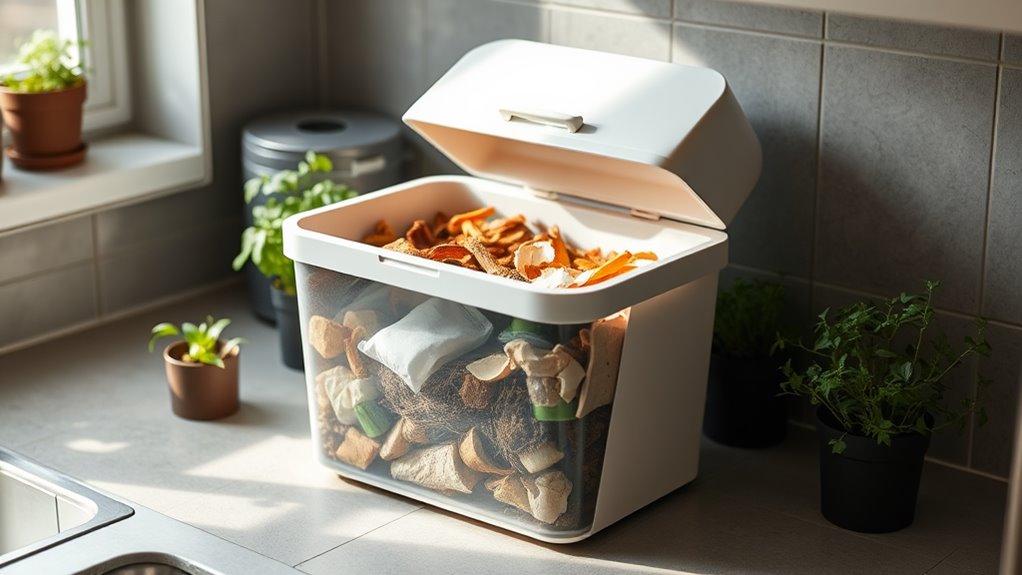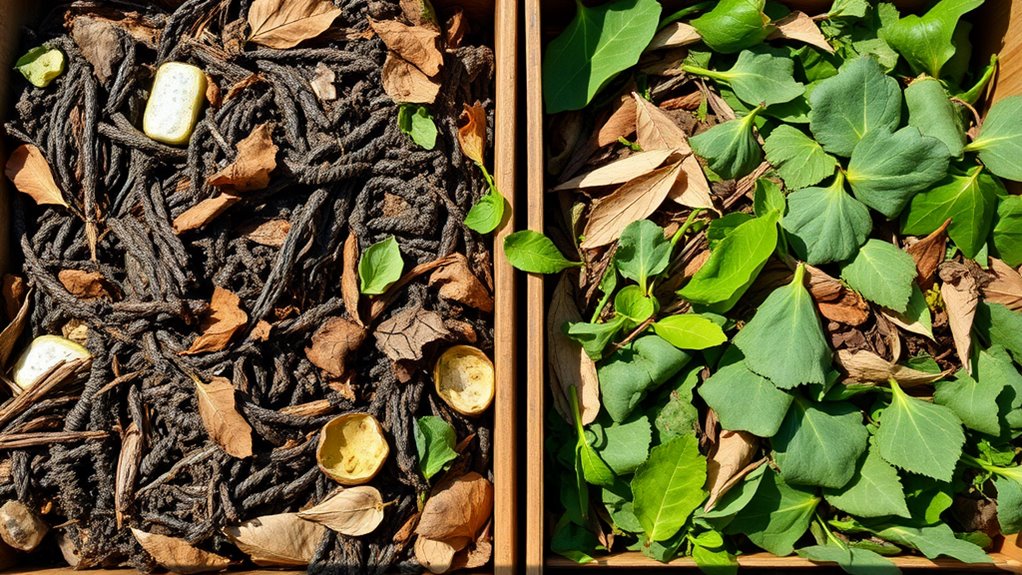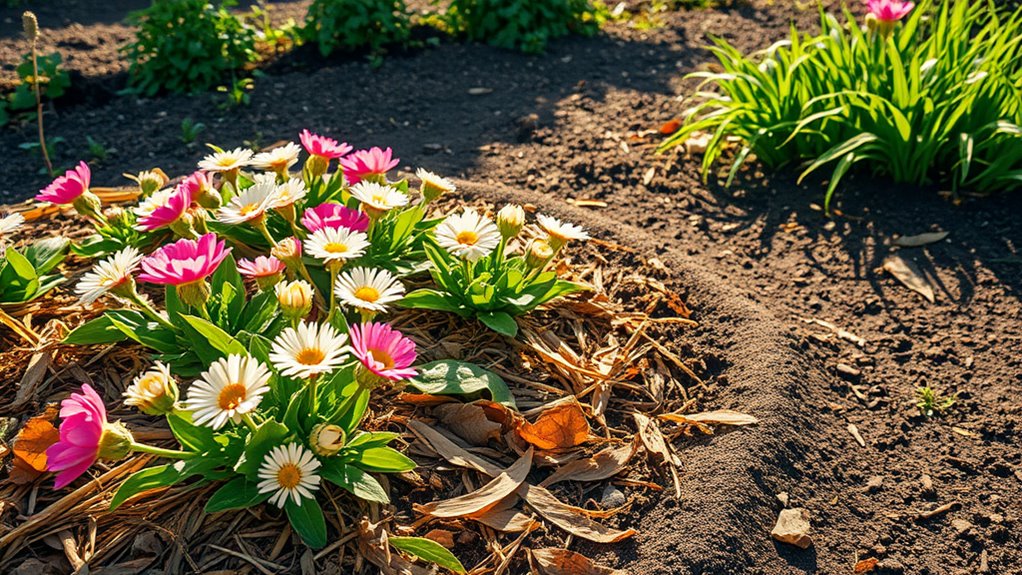The Best Way to Start Composting – Even in Small Spaces
You can easily kick off composting in small spaces by picking a compact bin like a vermicomposting system, which fits neatly on a countertop. Start with a balanced mix—use greens such as kitchen scraps for nitrogen and browns like shredded paper for carbon, aiming for a 2:1 to 3:1 ratio. Build your pile on a base of twigs for airflow, keep it moist like a wrung-out sponge, and turn it weekly to manage odors and pests. As you master these basics, more advanced techniques will help you maximize your setup’s potential.
Key Takeaways
- Choose a compact composting system, like vermicomposting or wall-mounted bins, to maximize space efficiency.
- Balance greens (like kitchen scraps) and browns (like dry leaves) in a 2:1 to 3:1 ratio for optimal decomposition.
- Start with a base layer of coarse materials, such as twigs, to ensure good airflow in small setups.
- Cover food scraps with browns to minimize odors and pests, keeping the area tidy.
- Monitor moisture levels regularly, aiming for a damp sponge consistency, and turn the pile weekly for best results.
Choosing the Right Compost Bin
When you’re composting in a small space, choosing the right bin can make all the difference in keeping things efficient and odor-free.
For composting for beginners, start with compact options like vermicomposting or bokashi systems, which are designed for limited areas and use natural processes to speed up decomposition.
Evidence from environmental studies shows that bins with proper ventilation and sealed lids minimize odors by promoting aerobic activity, preventing anaerobic buildup.
As a beginner, you’ll find features like easy-access doors and built-in filters essential for maintenance, making your setup manageable and effective without overwhelming complexity.
This approach helps you build sustainable habits quickly. To further enrich your compost, incorporate kitchen scraps from everyday waste to recycle nutrients back into your garden.
Incorporating these low-effort methods enables busy beginners to produce nutrient-rich compost with minimal time investment.
Selecting Suitable Materials
Selecting the right materials for your compost bin is crucial for maintaining balance and efficiency in small spaces.
You’ll need “greens” like fruit and vegetable scraps for nitrogen, which fuel microbial activity, and “browns” such as dry leaves or paper for carbon, promoting aeration. By using kitchen scraps effectively, you can produce nutrient-rich soil to enhance your garden’s sustainability.
Aim for a 25-30:1 carbon-to-nitrogen ratio, based on composting research, to prevent excess moisture and odors.
In limited areas, choose finely chopped items that decompose quickly and avoid greasy residues, as these can attract pests.
This approach keeps your setup balanced and effective.
For even better results, try incorporating ingredient swaps to boost decomposition and achieve richer soil.
Starting Your Compost Pile
Now that you’re ready to start your compost pile, you begin by choosing a location that’s convenient and well-drained to ensure effective decomposition. By following an easy composting routine, you can produce nutrient-rich black gold soil to enhance your garden’s health.
Next, you gather materials like green waste, brown matter, and a compost bin to balance the mix for optimal results.
Finally, you build the base layer with coarse materials such as twigs or shredded paper to promote airflow and prevent sogginess.
Maintaining a successful compost system in small spaces involves regular monitoring of moisture levels to support ongoing decomposition.
Choose Location
The right location for your compost pile sets the foundation for successful decomposition, especially in small spaces where space is limited.
Choose a spot that’s accessible yet discreet, like a balcony or shaded corner, to ease maintenance without cluttering your area.
Prioritize good drainage to prevent waterlogging, which can stifle microbial activity and create odors.
In urban settings, select a site with partial shade to retain moisture and reduce evaporation, ensuring efficient breakdown.
Gather Materials
Once you’ve selected your composting spot, gather a balanced mix of green and brown materials to fuel the decomposition process.
Green materials, like fruit and vegetable scraps, coffee grounds, and grass clippings, provide nitrogen that activates microbes for breakdown.
Brown materials, such as dried leaves, straw, shredded paper, and cardboard, supply carbon to maintain structure and prevent compaction.
Aim for a 2-3:1 brown-to-green ratio, based on composting research, to ensure efficient microbial activity and avoid excess moisture.
Collect these from your kitchen and yard to minimize waste and promote sustainability.
Build Base Layer
With your materials ready, you lay down a base layer of brown items like dried leaves or shredded paper, aiming for 4-6 inches thick to promote airflow and drainage. This foundation ensures aerobic conditions, preventing odors and supporting microbial activity, which speeds up decomposition in limited spaces.
-
Select carbon-rich materials****: Choose dry leaves or paper to maintain a high carbon-to-nitrogen ratio, as studies show this balances compost pH and reduces acidity.
-
Ensure even layering****: Spread the base uniformly to avoid compaction, allowing oxygen to penetrate and enhance breakdown efficiency.
-
Monitor thickness: Keep it at 4-6 inches for optimal drainage, backed by research indicating this prevents waterlogging and fosters healthier microbial ecosystems.
Balancing Greens and Browns
Achieving a balance between greens and browns ensures your compost pile decomposes efficiently. Greens, like fruit scraps and grass clippings, provide nitrogen for microbes, while browns, such as dried leaves and cardboard, supply carbon for energy. Aim for a 2:1 to 3:1 browns-to-greens ratio to prevent sogginess or slowness.
| Material Type | Examples | Role in Compost |
|---|---|---|
| Greens | Kitchen scraps, grass | Adds nitrogen |
| Browns | Dried leaves, paper | Provides carbon |
| Greens | Vegetable peels | Fuels microbial activity |
| Browns | Cardboard, straw | Balances moisture |
| Mix | Balanced layers | Ensures even breakdown |
You maintain this by layering materials, promoting faster decomposition.
Managing Odor and Pests
While improper composting can attract pests or produce unpleasant odors, you’ll need to take proactive steps to keep your pile in check. Effective management relies on evidence-based practices to maintain a healthy compost system. Moreover, exploring natural remedies can provide additional ways to manage pests effectively.
For instance, studies show that balancing moisture and aeration minimizes issues.
To address these challenges:
-
Cover food scraps: Always bury kitchen waste under a layer of browns like leaves to reduce odors and deter flies, as this limits exposure to air and pests.
-
Avoid problem materials: Exclude meat, dairy, and oily foods, which research indicates attract rodents and cause foul smells, opting instead for plant-based items.
-
Maintain proper moisture: Keep your pile as damp as a wrung-out sponge; excess water leads to anaerobic conditions and odors, while dryness slows decomposition.
By implementing these strategies, you can effectively troubleshoot common issues and promote rich, healthy soil in your garden.
Monitoring and Turning the Compost
Regularly monitoring and turning your compost pile ensures it decomposes efficiently and stays balanced. You’ll check temperature, moisture, and material mix to prevent issues like anaerobic conditions. Turning introduces oxygen, accelerating breakdown and controlling odors—aim for once a week with a pitchfork.
By using simple techniques, you can effectively transform kitchen scraps into valuable compost that enriches your garden.
| What to Monitor | Why It Matters |
|---|---|
| Temperature | Keeps it at 130-160°F for pathogen kill; turn if cooling. |
| Moisture Level | Should feel like a wrung-out sponge; add water or dry material as needed. |
| Material Balance | Equal greens and browns prevent sliminess; adjust ratios. |
| Odor | Earthy smell is good; turn to fix foul odors from imbalance. |
| Pile Appearance | Uniform decomposition; mix in new additions evenly. |
Expanding Your Setup in Limited Areas
As you expand your composting setup in limited areas, you’ll benefit from vertical space ideas like stacking bins or using wall-mounted systems to increase capacity without extra floor space.
You can apply compact setup tips, such as multi-tiered trays or modular designs, to optimize airflow and decomposition efficiency.
These approaches enable you to grow your composting efforts while staying organized and effective in tight quarters.
To avoid potential pitfalls, remember to incorporate valuable lessons from common composting mistakes that have nearly destroyed gardens in the past.
Vertical Space Ideas
When space is at a premium, you can optimize your composting setup by exploring vertical space ideas, such as stacking bins or installing wall-mounted systems.
This method helps you utilize unused areas effectively, enhancing efficiency in tight spots.
-
Stack bins vertically: Layer multiple bins to create a compact tower, promoting faster decomposition through gravity-fed aeration and reducing ground space needs.
-
Install wall-mounted systems: Secure composters to walls for better airflow and accessibility, as studies show this improves moisture control and pest resistance.
-
Use hanging or shelf units****: Position compost holders on shelves to organize materials, allowing you to monitor progress without expanding horizontally, thus maintaining a tidy setup.
Compact Setup Tips
To build on vertical space strategies, you optimize your composting setup in confined areas by adopting compact tips that enable expansion, such as modular bins or multi-level organizers, which research shows can double capacity while minimizing footprint and maintaining decomposition rates.
For instance, you’re stacking these units to fit under counters, where studies from the EPA indicate they reduce waste volume by up to 50% without slowing microbial activity.
Choose breathable materials like wire mesh to enhance airflow, ensuring efficient breakdown.
Regularly rotate contents to prevent compaction, maximizing nutrient-rich output in tight spots like apartments.





